1715-ElecFilter_FM.qxd 06/09/06 17:02 Page i
6x9 Handbook / Electronic Filter Design / Williams & Taylor /147171-5 / Front Matter
ELECTRONIC
FILTER DESIGN
HANDBOOK
Arthur B. Williams
Fred J.Taylor
Fourth Edition
McGRAW-HILL
New York Chicago San Francisco Lisbon London Madrid
Mexico City Milan New Delhi San Juan Seoul
Singapore Sydney Toronto
�
1715-ElecFilter_FM.qxd 06/09/06 17:02 Page ii
6x9 Handbook / Electronic Filter Design / Williams & Taylor /147171-5 / Front Matter
Copyright © 2006 by The McGraw-Hill Companies, Inc. All rights reserved. Printed
in the United States of America. Except as permitted under the United States
Copyright Act of 1976, no part of this publication may be reproduced or distributed
in any form or by any means, or stored in a data base or retrieval system, without the
prior written permission of the publisher.
1 2 3 4 5 6 7 8 9 0 DOC/DOC 0 1 9 8 7 6
ISBN 0-07-147171-5
The sponsoring editor for this book was Wendy Rinaldi, the editing supervisor
was Jody McKenzie, and the production supervisor was Jean Bodeaux. It was set
in Times Roman by International Typesetting and Composition. The art director
for the cover was Handel Low.
Printed and bound by RR Donnelley.
McGraw-Hill books are available at special quantity discounts to use as premiums and
sales promotions, or for use in corporate training programs. For more information,
please write to the Director of Special Sales, McGraw-Hill Professional, Two Penn
Plaza, New York, NY 10121-2298. Or contact your local bookstore.
Information contained in this work has been obtained by The McGraw-
Hill Companies, Inc. (“McGraw-Hill”) from sources believed to be reli-
able. However, neither McGraw-Hill nor its authors guarantee the
accuracy or completeness of any information published herein, and nei-
ther McGraw-Hill nor its authors shall be responsible for any errors,
omissions, or damages arising out of use of this information. This work
is published with the understanding that McGraw-Hill and its authors are
supplying information but are not attempting to render engineering or
other professional services. If such services are required, the assistance
of an appropriate professional should be sought.
�
1715-ElecFilter_FM.qxd 06/09/06 17:02 Page iii
6x9 Handbook / Electronic Filter Design / Williams & Taylor /147171-5 / Front Matter
From Arthur B. Williams
To my Family
Ellen, Howard, Bonnie, Robin, Mitchell
and grandchildren Leviah and Ilona
From Dr. Fred J. Taylor
To my grandchildren Schuyler, Bennett,
and Graysen and their
devoted grandmother Lori
�
1715-ElecFilter_FM.qxd 06/09/06 17:02 Page iv
6x9 Handbook / Electronic Filter Design / Williams & Taylor /147171-5 / Front Matter
ABOUT THE AUTHORS
Arthur Williams is the Chief Scientist at Telebyte Inc., a developer and manufacturer of
broadband test equipment and data communication products. Previously, he was Senior Staff
Engineer and Manager of Engineering for Tellabs Inc. Author of five books and holder of
eleven patents, Mr. Williams has served as a consultant to the industry and is currently the
Chairman of the IEEE Circuits and Systems (CAS) chapter on Long Island.
Fred J. Taylor is co-founder and Chairman of the Board of the Athena Group, a DSP semi-
conductor silicon intellectual property company and education technology innovator. He is
also professor of electrical and computer engineering, and computer and information science
engineering at the University of Florida. Author of ten textbooks and holder of three patents,
Dr. Taylor serves as a consultant to Fortune 500 companies and government agencies.
iv
�
1715-ElecFilter_FM.qxd 06/09/06 17:02 Page v
6x9 Handbook / Electronic Filter Design / Williams & Taylor /147171-5 / Front Matter
CONTENTS
Preface
xiii
Chapter 1. Introduction to Modern Network Theory
1.1. Modern Network Theory / 1
The Pole-Zero Concept
/ 1
Synthesis of Filters from Polynomials / 2
Active vs. Passive Filters / 7
Bibliography / 8
Chapter 2. Selecting the Response Characteristic
1
9
2.1. Frequency-Response Normalization / 9
Frequency and Impedance Scaling / 9
Low-Pass Normalization / 12
High-Pass Normalization / 14
Bandpass Normalization / 16
Band-Reject Normalization / 24
2.2. Transient Response / 29
The Effect of Nonuniform Time Delay / 29
Step Response of Networks / 32
Impulse Response / 34
Estimating Transient Characteristics / 34
2.3. Butterworth Maximally Flat Amplitude / 42
2.4. Chebyshev Response / 47
2.5. Bessel Maximally Flat Delay / 52
2.6. Linear Phase with Equiripple Error
2.7. Transitional Filters / 64
2.8. Synchronously Tuned Filters / 70
2.9. Elliptic-Function Filters / 79
/ 64
Using the Filter Solutions (Book Version) Software for Design of Elliptic Function Low-
Pass Filters / 86
Using the ELI 1.0 Program for the Design of Odd-Order Elliptic-Function Low-Pass Filters
up to the 31st Order
/ 87
2.10. Maximally Flat Delay with Chebyshev Stopband / 88
Bibliography / 88
Chapter 3. Low-Pass Filter Design
89
3.1. LC Low-Pass Filters / 89
All-Pole Filters / 89
v
�
1715-ElecFilter_FM.qxd 06/09/06 17:02 Page vi
6x9 Handbook / Electronic Filter Design / Williams & Taylor /147171-5 / Front Matter
vi
CONTENTS
Elliptic-Function Filters / 90
Duality and Reciprocity / 93
Designing for Unequal Terminations / 93
Effects of Dissipation / 97
Using Predistorted Designs / 99
3.2. Active Low-Pass Filters / 103
All-Pole Filters / 103
VCVS Uniform Capacitor Structure / 113
The Low-Sensitivity Second-Order Section / 114
Elliptic-Function VCVS Filters / 116
State-Variable Low-Pass Filters / 120
Generalized Impedance Converters / 128
Bibliography / 135
Chapter 4. High-Pass Filter Design
4.1. LC High-Pass Filters / 137
The Low-Pass to High-Pass Transformation / 137
The T-to-Pi Capacitance Conversion / 142
4.2. Active High-Pass Filters / 143
The Low-Pass to High-Pass Transformation / 143
All-Pole High-Pass Filters / 144
Elliptic-Function High-Pass Filters / 145
State-Variable High-Pass Filters / 151
High-Pass Filters Using the GIC / 159
Active Elliptic-Function High-Pass Filters Using the GIC / 161
Bibliography / 164
Chapter 5. Bandpass Filters
5.1. LC Bandpass Filters / 165
Wideband Filters / 165
Narrowband Filters / 167
Narrowband Coupled Resonators / 183
Predistorted Bandpass Filters / 189
Elliptic-Function Bandpass Filers / 192
5.2. Active Bandpass Filters / 199
Wideband Filters / 199
137
165
The Bandpass Transformation of Low-Pass Poles and Zeros / 202
Sensitivity in Active Bandpass Circuits / 207
All-Pole Bandpass Configurations / 207
Elliptic-Function Bandpass Filters / 224
State-Variable (Biquad) Circuit
/ 230
Bibliography / 237
Chapter 6. Band-Reject Filters
239
6.1. LC Band-Reject Filters / 239
The Band-Reject Circuit Transformation / 239
All-Pole Band-Reject Filters / 240
Elliptic-Function Band-Reject Filters / 245
Null Networks / 252
6.2. Active Band-Reject Filters / 257
Wideband Active Band-Reject Filters / 257
�
1715-ElecFilter_FM.qxd 06/09/06 17:02 Page vii
6x9 Handbook / Electronic Filter Design / Williams & Taylor /147171-5 / Front Matter
vii
279
CONTENTS
Band-Reject Transformation of Low-Pass Poles / 261
Narrowband Active Band-Reject Filters / 265
Active Null Networks / 271
Bibliography / 277
Chapter 7. Networks for the Time Domain
7.1. All-Pass Transfer Functions / 279
First-Order All-Pass Transfer Functions / 279
Second-Order All-Pass Transfer Functions / 281
7.2. Delay Equalizer Sections / 283
LC All-Pass Structures / 283
Active All-Pass Structures / 287
7.3. Design of Delay Lines / 292
The Low-Pass to All-Pass Transformation / 292
LC Delay Lines / 293
Active Delay Lines / 297
7.4. Delay Equalization of Filters / 299
First-Order Equalizers / 300
Second-Order Equalizers / 303
7.5. Wideband 90° Phase-Shift Networks / 307
7.6. Adjustable Delay and Amplitude Equalizers / 313
LC Delay Equalizers / 314
LC Delay and Amplitude Equalizers / 316
Active Delay and Amplitude Equalizers / 319
Bibliography / 323
Chapter 8. Refinements in LC Filter Design
and the Use of Resistive Networks
325
8.1. Introduction / 325
8.2. Tapped Inductors / 325
8.3. Circuit Transformations / 327
Norton’s Capacitance Transformer
Narrowband Approximations / 330
/ 328
8.4. Designing with Parasitic Capacitance / 333
8.5. Amplitude Equalization for Inadequate Q / 336
8.6. Coil-Saving Elliptic-Function Bandpass Filters / 340
8.7. Filter Tuning Methods / 343
8.8. Measurement Methods / 345
Insertion Loss and Frequency Response / 345
Input Impedance of Filter Networks / 346
Time-Domain Characteristics / 347
Measuring the Q of inductors / 351
8.9. Designing for Unequal Impedances / 351
Impedance Matching / 351
Exponentially Tapered Impedance Scaling / 351
Minimum Loss Resistive Pad for Impedance Matching / 352
8.10. Symmetrical Attenuators / 355
Bridged T Attenuator
8.11. Power Splitters / 357
/ 356
Resistive Power Splitters / 357
A Magic-T Splitter
/ 357
Bibliography / 360
�
1715-ElecFilter_FM.qxd 06/09/06 17:02 Page viii
6x9 Handbook / Electronic Filter Design / Williams & Taylor /147171-5 / Front Matter
viii
CONTENTS
Chapter 9. Design and Selection of Inductors for LC Filters
361
9.1. Basic Principles of Magnetic-Circuit Design / 361
Units of Measurement
/ 361
Saturation and DC Polarization / 362
Inductor Losses / 363
Effect of an Air Gap / 363
The Design of Coil Windings / 364
9.2. MPP Toroidal Coils / 367
Characteristics of Cores / 367
Winding Methods for Q Optimization / 371
Designing MPP Toroids from Q Curves / 372
9.3. Ferrite Pot Cores / 376
The Pot Core Structure / 376
Electrical Properties of Ferrite Pot Cores / 377
Winding of Bobbins / 380
RM Cores / 382
9.4. High-Frequency Coil Design / 383
Powdered-Iron Toroids / 383
Winding Methods / 384
Air-Core Inductors / 387
Surface Mount RF Inductors / 387
Bibliography / 392
Chapter 10. Component Selection for LC and Active Filters
393
10.1. Capacitor Selection / 393
Properties of Dielectrics / 393
Capacitor Construction / 394
Selecting Capacitors for Filter Applications / 398
10.2. Resistors / 403
Fixed Resistors / 403
Variable Resistors / 408
Resistor Johnson (Thermal) Noise / 409
10.3. Operational Amplifiers / 410
A Review of Basic Operational-Amplifier Theory / 410
An Analysis of Non-Ideal Amplifiers / 413
Practical Amplifier Considerations / 415
Operational Amplifier Selection / 417
A Survey of Popular Amplifier Types / 419
10.4. General Manufacturing Considerations / 422
Bibliography / 423
Chapter 11. Normalized Filter Design Tables
Chapter 12. Introduction to Digital Filters
12.1. Introduction to Signal Processing / 497
12.2. Introduction to Digital Signal Processing (DSP)
12.3. The Relation to Analog Filters / 498
/ 497
Digital Advantages / 498
Analog Advantages / 499
12.4. Signal Representation / 500
425
497
�
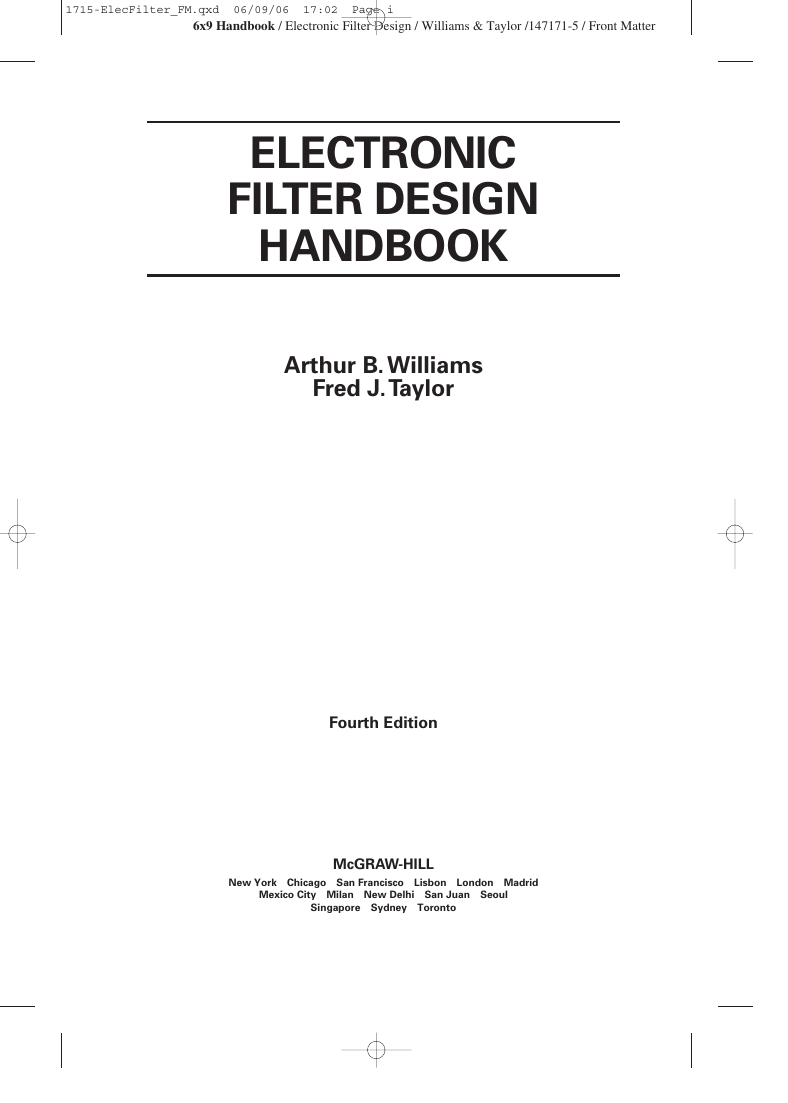
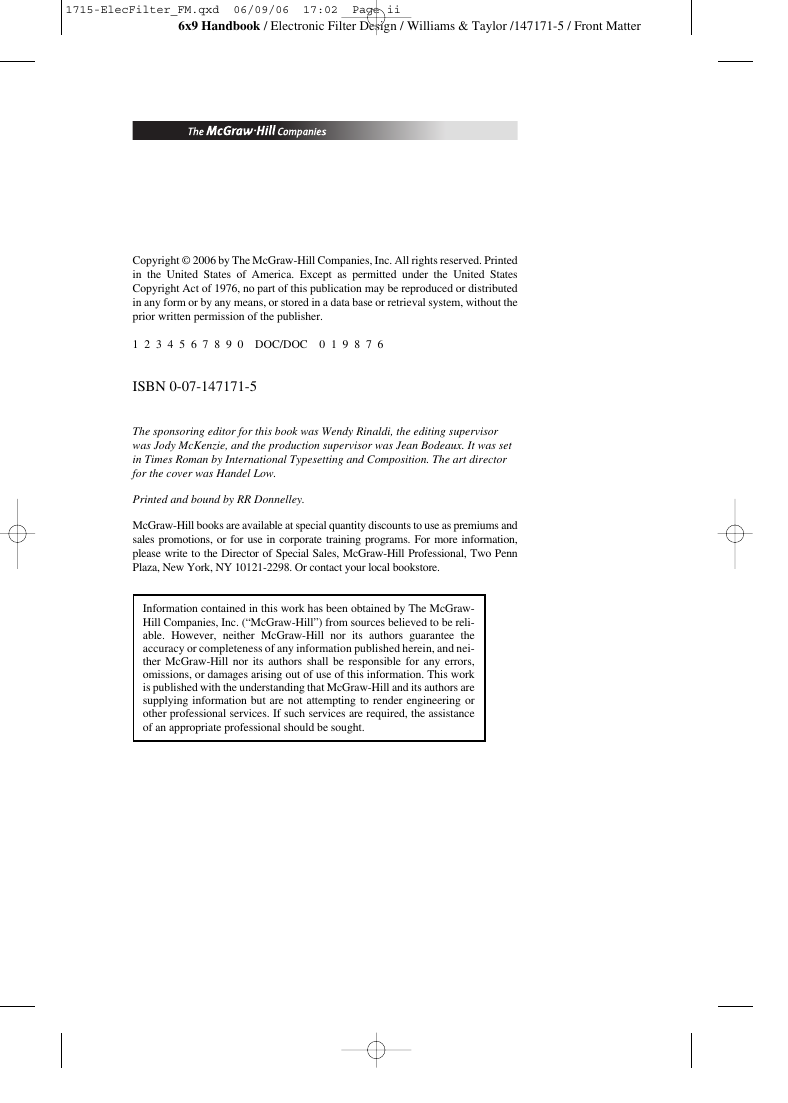

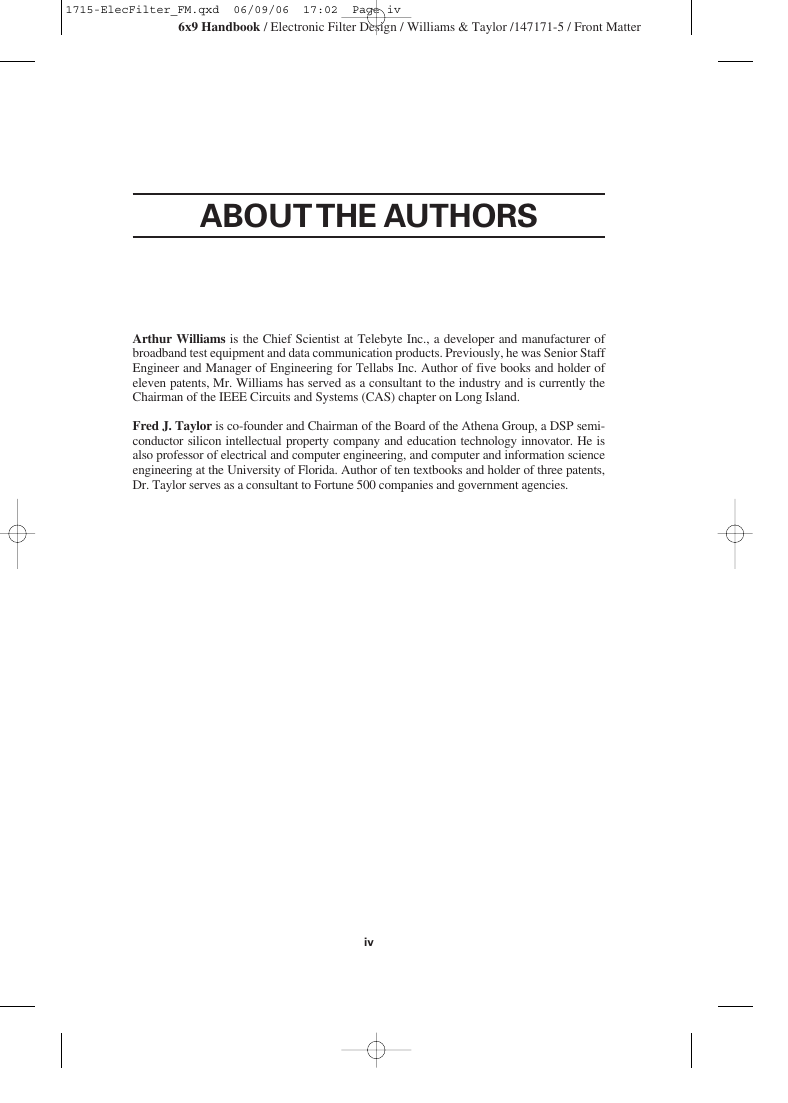
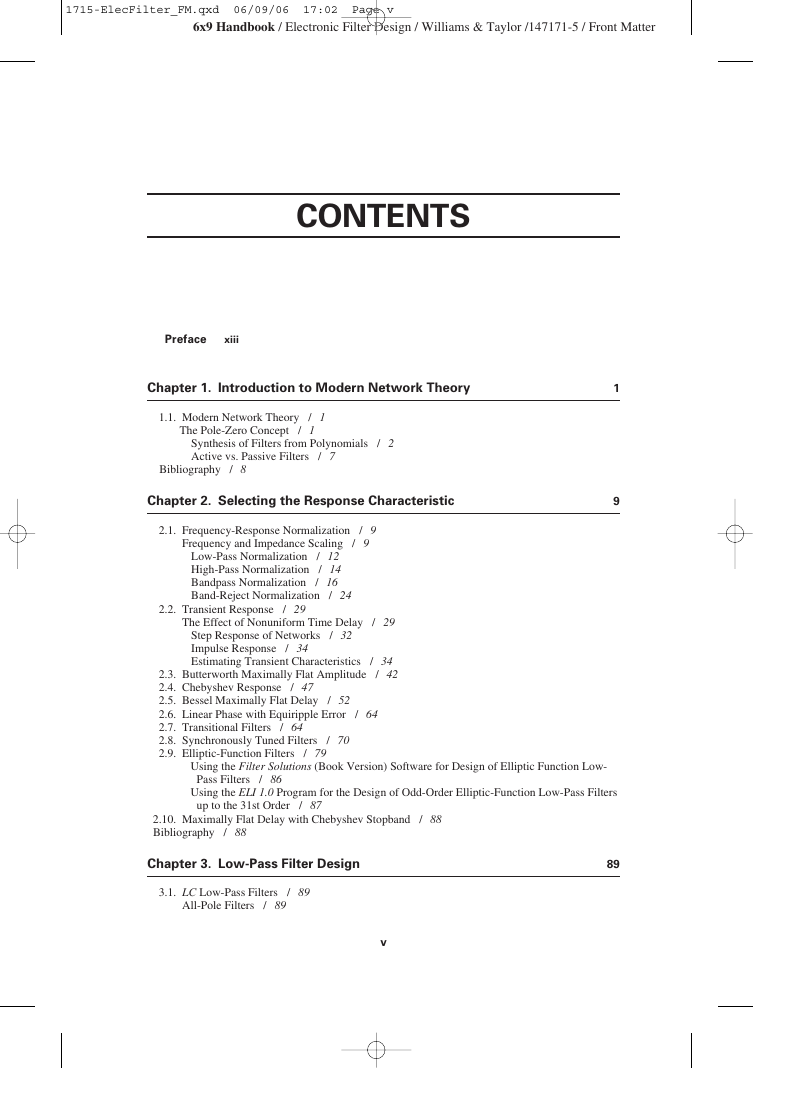
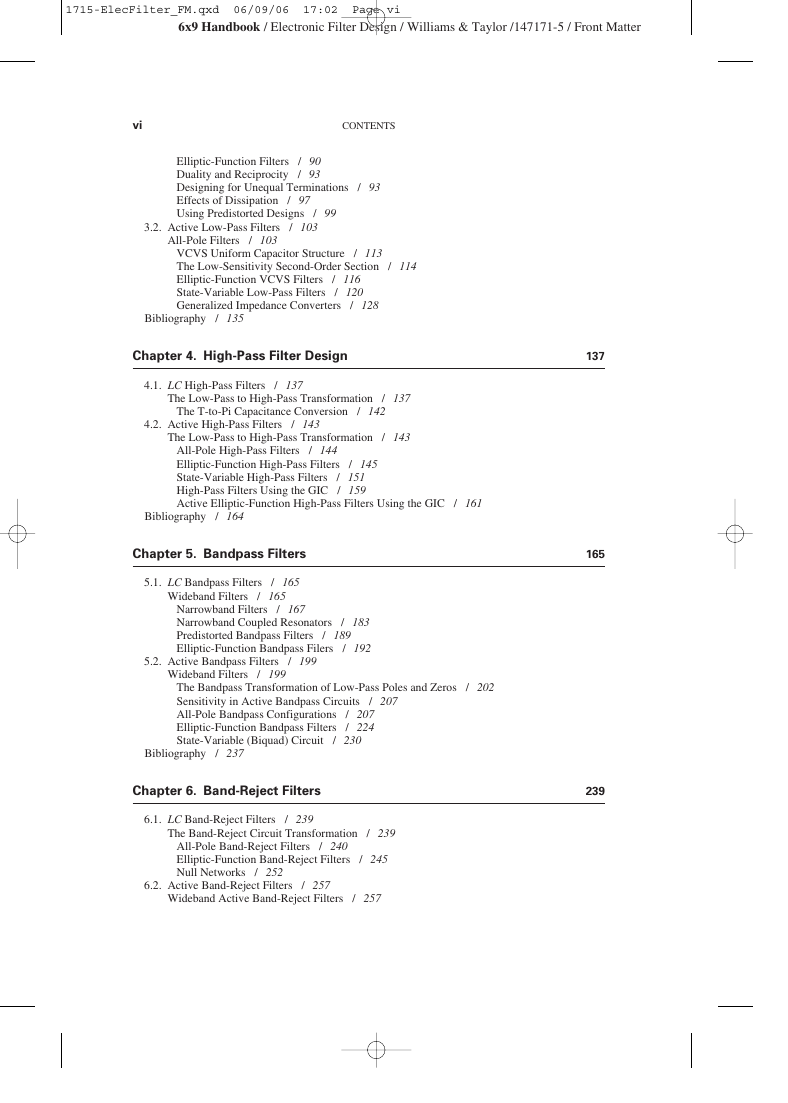










 2023年江西萍乡中考道德与法治真题及答案.doc
2023年江西萍乡中考道德与法治真题及答案.doc 2012年重庆南川中考生物真题及答案.doc
2012年重庆南川中考生物真题及答案.doc 2013年江西师范大学地理学综合及文艺理论基础考研真题.doc
2013年江西师范大学地理学综合及文艺理论基础考研真题.doc 2020年四川甘孜小升初语文真题及答案I卷.doc
2020年四川甘孜小升初语文真题及答案I卷.doc 2020年注册岩土工程师专业基础考试真题及答案.doc
2020年注册岩土工程师专业基础考试真题及答案.doc 2023-2024学年福建省厦门市九年级上学期数学月考试题及答案.doc
2023-2024学年福建省厦门市九年级上学期数学月考试题及答案.doc 2021-2022学年辽宁省沈阳市大东区九年级上学期语文期末试题及答案.doc
2021-2022学年辽宁省沈阳市大东区九年级上学期语文期末试题及答案.doc 2022-2023学年北京东城区初三第一学期物理期末试卷及答案.doc
2022-2023学年北京东城区初三第一学期物理期末试卷及答案.doc 2018上半年江西教师资格初中地理学科知识与教学能力真题及答案.doc
2018上半年江西教师资格初中地理学科知识与教学能力真题及答案.doc 2012年河北国家公务员申论考试真题及答案-省级.doc
2012年河北国家公务员申论考试真题及答案-省级.doc 2020-2021学年江苏省扬州市江都区邵樊片九年级上学期数学第一次质量检测试题及答案.doc
2020-2021学年江苏省扬州市江都区邵樊片九年级上学期数学第一次质量检测试题及答案.doc 2022下半年黑龙江教师资格证中学综合素质真题及答案.doc
2022下半年黑龙江教师资格证中学综合素质真题及答案.doc